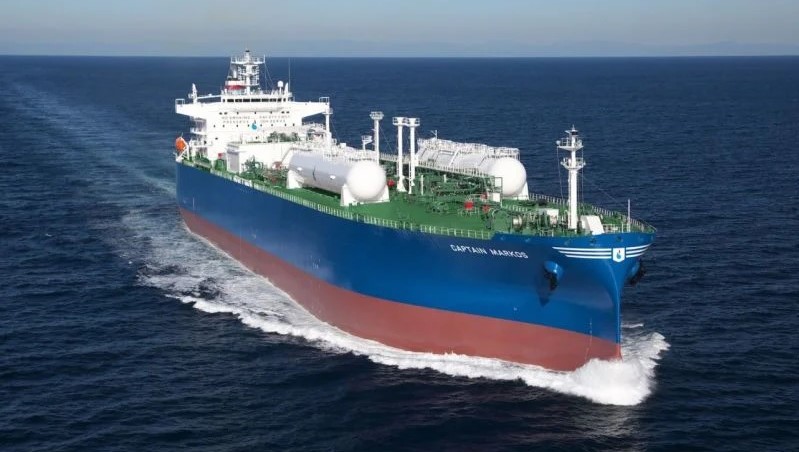Delivery of LPG-fueled LPG carrier 'CAPTAIN MARKOS'

Kawasaki Heavy Industries, Ltd. has delivered the 84,000m3 LPG (liquefied petroleum gas) fueled LPG carrier " CAPTAIN MARKOS ".
The vessel is an LPG dual-fuel LPG carrier fueled by LPG and low-sulfur fuel oil . This is the 7th ship of the new type that adopts the LPG dual fuel main engine to the conventional 84,000 m3 LPG carrier. She is also the 70th LPG carrier delivered by the Company.
In recent years, the introduction of ships that use liquefied gas instead of heavy oil as fuel is progressing worldwide as an effective measure to comply with ship exhaust gas regulations. The ship is a large LPG carrier that is expected to significantly reduce the environmental burden by using LPG as fuel, which can reduce greenhouse gas emissions. The NYK Group utilizes the knowledge it has accumulated through the construction of LPG carriers, LNG (liquefied natural gas) carriers, and LNG -fueled ships.
In the future, based on environmental regulations that are being strengthened worldwide and concrete action plans represented by the SDGs, we will continue to develop various types of LPG- fueled LPG carriers, LPG / ammonia carriers, etc. that comply with environmental regulations. We will contribute to the realization of a low-carbon and decarbonized society by developing and providing environment-friendly ship technologies such as commercial ships and liquefied hydrogen carriers, which are attracting attention as next-generation energy.
Main item:
|
Features:
| 1) | The main engine is Kawasaki's electronically controlled liquefied petroleum gas injection diesel engine ( ME-LGIP engine) "Kawasaki - MAN B&W 7S60ME-C10.5-LGIP ". By using LPG as fuel, SOx ( sulfur oxide ) and CO2 emissions in the exhaust gas can be greatly reduced compared to the use of conventional fuel oil . It also conforms to the required EEDI Phase 3 *2 . |
| 2) | Adopting a system that complies with NOx (nitrogen oxides ) Tier 3 regulations *3 , the main engine is an exhaust gas recirculation system ( EGR ) * 4 , and the power generation engine is a selective reduction catalytic denitrification system ( SCR ) * 5 . increase. With this system, it is possible to navigate NOx emission control areas ( ECA ) even when using conventional low-sulfur fuel oil . |
| 3) | By installing an LPG fuel tank on the upper deck , LPG for fuel can be loaded separately from cargo. In addition, since the LPG fuel tank is connected to the cargo tank by piping, it is possible to transfer LPG from the cargo tank and use it as fuel as needed . |
| 4) | A rudder valve with Kawasaki fins and a semi-duct with contra fins around the propeller reduce fuel consumption. |
| * 1 | SOx emission regulations: From January 2015 , the IMO has enforced SOx emission regulations for fuel sulfur content of 0.1% or less in Emission Control Areas ( ECA ) in Europe and the United States. In addition, from January 2020 , ships sailing in all other sea areas of the world must use fuel with a sulfur content of 0.5 % or less, or use alternative equipment that reduces SOx from exhaust gas to the same level . is obligatory. |
|
| * 2 | EEDI ( Energy Efficiency Design Index ) regulation: The Energy Efficiency Design Index (EEDI), which is defined as the number of grams of CO2 emitted when carrying 1 ton of cargo for 1 mile , is used to meet the regulation value for energy-saving performance of new ships. International regulations mandating compliance with EEDI regulation values ​​will be strengthened in stages according to the construction contract date and delivery date. For some ship types, such as large LPG carriers and LNG (liquefied natural gas) carriers, Phase 3 ( 30% CO 2 reduction from baseline ) is required from 2022 onwards for contracted ships . |
|
| * 3 | NOx emission regulation: The IMO regulates NOx emissions from ships , and the Tier 3 regulation, which has been in effect since 2016 , limits emission control areas ( ECA ) in Europe and the United States as designated sea areas, and the Tier 1 regulation value is further increased by 80% . % reduction is provided. |
|
| * 4 | Exhaust gas recirculation system ( EGR ): Part of the exhaust gas from the main engine is washed with clean water and returned to the main engine as combustion air, thereby lowering the oxygen concentration and combustion temperature of the combustion air and allowing nitrogen to undergo an oxidation reaction at high temperatures. It is a device that reduces NOx emissions by suppressing In addition, the cleaning water used to clean the exhaust gas is treated to be harmless by removing soot and oil before being discharged overboard. |
|
| * 5 | Selective catalytic reduction denitrification system ( SCR ): When urea water is sprayed onto the high-temperature exhaust gas of a power generation engine, it decomposes into ammonia, which reacts with NOx in the exhaust gas through a titanium-vanadium-based catalyst to produce nitrogen and water . This equipment reduces NOx emissions by reducing the |
